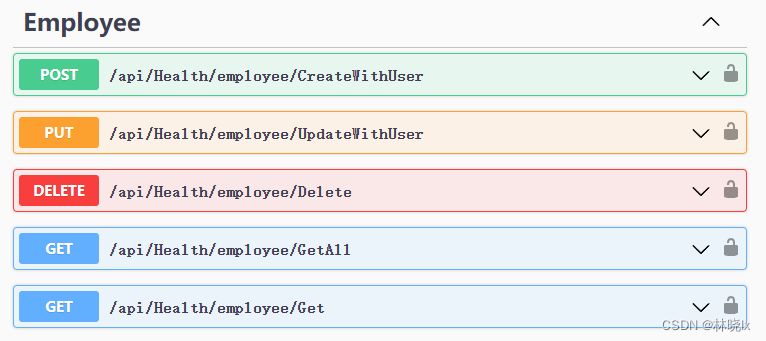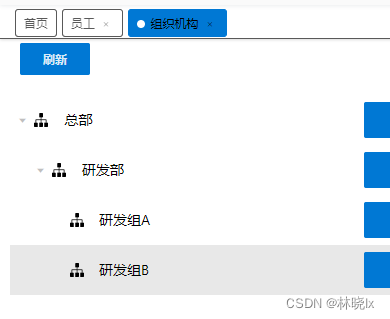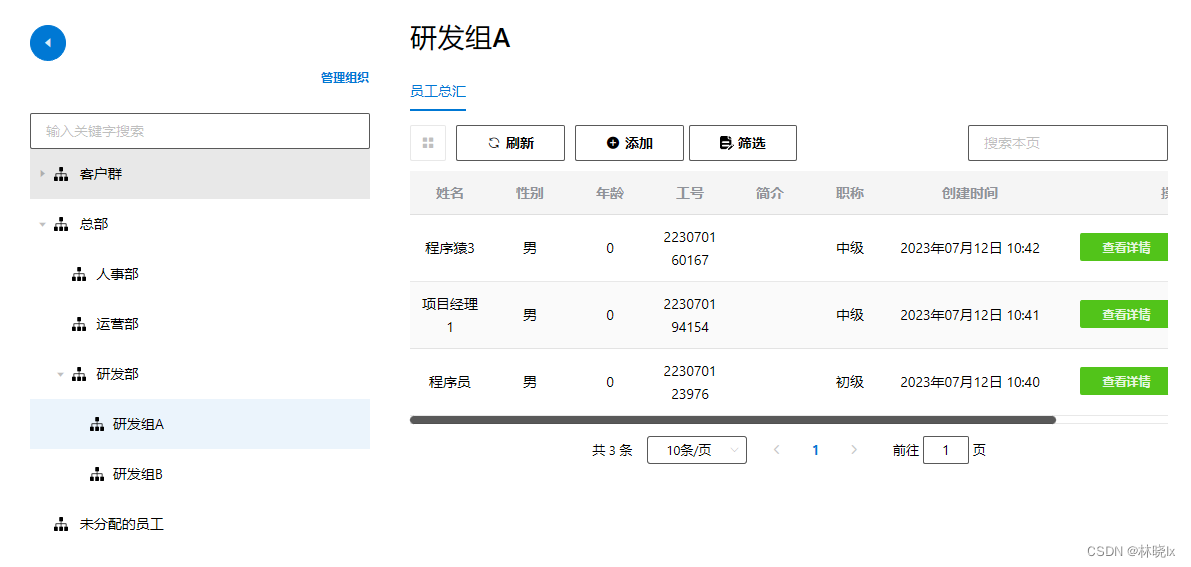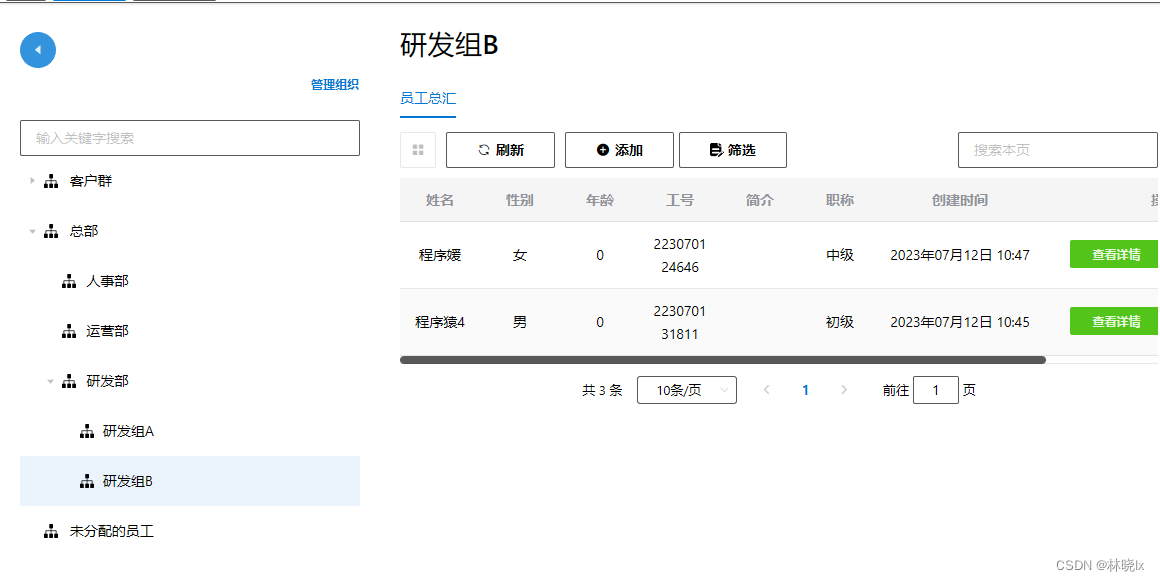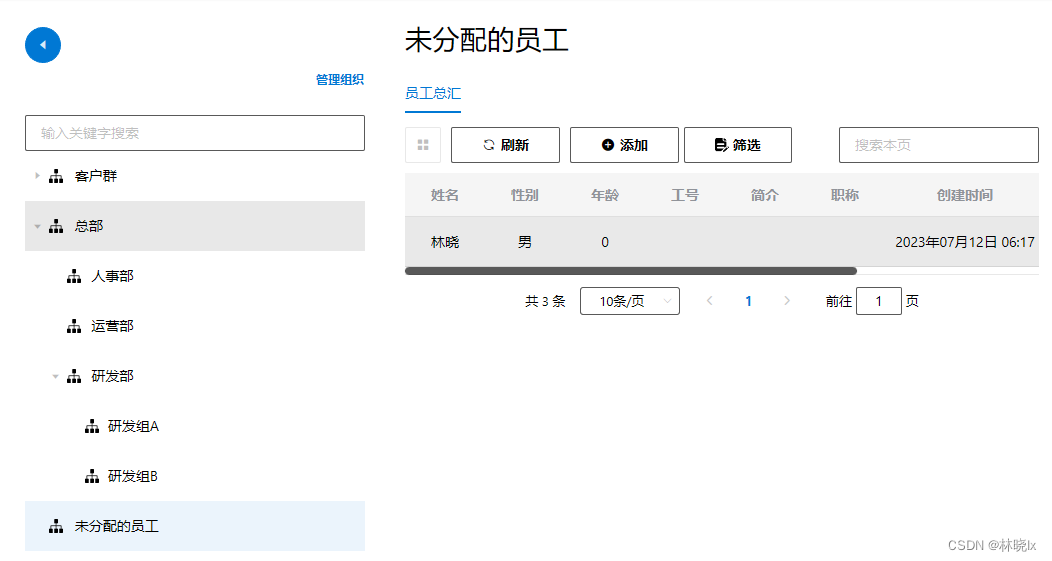创建业务用户 区别于身份管理模块(Identity模块)的鉴权用户IdentityUser,业务用户(BusinessUser)是围绕业务系统中“用户”这一定义的领域模型。如:在一个医院系统中,业务用户可以是医生、护士、患者;在一个OA系统中,业务用户可以是员工、管理员、客户等。
业务用户和鉴权用户由同步机制关联,业务用户通过分布式事件(DistributedEvent)的同步器(Synchronizer)与鉴权用户关联同步。
在Health业务模块中,定义两种业务用户:
Client: 客户;
Employee: 员工。
这些业务用户继承自HealthUser,HealthUser是业务用户的基类,包含了业务用户的基本信息,如姓名,性别,出生日期,身份证号等。并且需要实现IUpdateUserData接口,以便在同步鉴权用户信息时,更新业务用户的基本信息。
Employee包含工号,职称,简介等信息。其领域模型定义如下:
1 2 3 4 5 6 7 8 9 10 11 12 13 public class Employee : HealthUser<Guid>, IUser, IUpdateUserData { [StringLength(12)] public string EmployeeNumber { get; set; } [StringLength(64)] public string EmployeeTitle { get; set; } public string Introduction { get; set; } ... }
Client包含客户号,身高,体重,婚姻状况等信息。其领域模型定义如下:
1 2 3 4 5 6 7 8 9 10 11 12 13 14 15 16 17 18 19 20 21 22 public class Client : HealthUser<Guid>, IUser, IUpdateUserData { //unique [StringLength(12)] public string ClientNumber { get; set; } public string ClientNumberType { get; set; } [Range(0.0, 250.0)] public double? Height { get; set; } [Range(0.0, 1000.0)] public double? Weight { get; set; } public string Marriage { get; set; } public string Status { get; set; } }
创建业务用户同步器 以Client为例,ClientLookupService是业务用户的查询服务,其基类UserLookupService定义了关联用户的查询接口,包括按ID查询,按用户名查询,按组织架构查询,按户关系查询等。
创建ClientLookupService, 代码如下
1 2 3 4 5 6 7 8 9 10 11 12 13 14 15 16 17 18 public class ClientLookupService : UserLookupService<Client, IClientRepository>, IClientLookupService { public ClientLookupService( IClientRepository userRepository, IUnitOfWorkManager unitOfWorkManager) : base( userRepository, unitOfWorkManager) { } protected override Client CreateUser(IUserData externalUser) { return new Client(externalUser); } }
同步器订阅了分布式事件EntityUpdatedEto,当鉴权用户更新时,同步器将更新业务用户的基本信息。
创建ClientSynchronizer,代码如下
1 2 3 4 5 6 7 8 9 10 11 12 13 14 15 16 17 18 19 20 21 22 23 24 25 26 27 public class ClientSynchronizer : IDistributedEventHandler<EntityUpdatedEto<UserEto>>, ITransientDependency { protected IClientRepository UserRepository { get; } protected IClientLookupService UserLookupService { get; } public ClientSynchronizer( IClientRepository userRepository, IClientLookupService userLookupService) { UserRepository = userRepository; UserLookupService = userLookupService; } public async Task HandleEventAsync(EntityUpdatedEto<UserEto> eventData) { var user = await UserRepository.FindAsync(eventData.Entity.Id); if (user != null) { if (user.Update(eventData.Entity)) { await UserRepository.UpdateAsync(user); } } } }
创建业务用户应用服务 以Employee为例
在应用层中创建EmployeeAppService,在这里我们实现对业务用户的增删改查操作。
EmployeeAppService继承自CrudAppService,它是ABP框架提供的增删改查的基类,其基类定义了增删改查的接口,包括GetAsync,GetListAsync,CreateAsync,UpdateAsync,DeleteAsync等。
OrganizationUnit为业务用户的查询接口的按组织架构查询提供查询依据。OrganizationUnitAppService注入到EmployeeAppService中。
1 2 3 4 5 public class EmployeeAppService : CrudAppService<Employee, EmployeeDto, Guid, GetAllEmployeeInput, CreateEmployeeInput>, IEmployeeAppService { private readonly IOrganizationUnitAppService organizationUnitAppService; }
增 创建CreateWithUserAsync方法,用于创建业务用户。
1 2 3 4 5 6 7 8 9 10 11 12 13 14 15 16 17 18 public async Task<EmployeeDto> CreateWithUserAsync(CreateEmployeeWithUserInput input) { var createdUser = await identityUserAppService.CreateAsync(input); await CurrentUnitOfWork.SaveChangesAsync(); var currentEmployee = await userLookupService.FindByIdAsync(createdUser.Id); ObjectMapper.Map(input, currentEmployee); var updatedEmployee = await Repository.UpdateAsync(currentEmployee); var result = ObjectMapper.Map<Employee, EmployeeDto>(updatedEmployee); if (input.OrganizationUnitId.HasValue) { await organizationUnitAppService.AddToOrganizationUnitAsync( new UserToOrganizationUnitInput() { UserId = createdUser.Id, OrganizationUnitId = input.OrganizationUnitId.Value }); } return result; }
删 删除接口由CrudAppService提供默认实现,无需重写。
改 创建UpdateWithUserAsync方法,用于更新业务用户。
1 2 3 4 5 6 7 8 9 10 11 12 13 14 15 public async Task<EmployeeDto> UpdateWithUserAsync(CreateEmployeeInput input) { var currentEmployee = await userLookupService.FindByIdAsync(input.Id); if (currentEmployee == null) { throw new UserFriendlyException("没有找到对应的用户"); } ObjectMapper.Map(input, currentEmployee); var updatedEmployee = await Repository.UpdateAsync(currentEmployee); var result = ObjectMapper.Map<Employee, EmployeeDto>(updatedEmployee); return result; }
查 查询单个实体接口由CrudAppService提供默认实现,无需重写。
查询集合:
以Employee为例,查询接口所需要的入参为:
OrganizationUnitId:按组织架构查询用户
创建GetAllEmployeeInput,代码如下
1 2 3 4 5 6 7 8 public class GetAllEmployeeInput : PagedAndSortedResultRequestDto { public string EmployeeTitle { get; set; } public Guid? OrganizationUnitId { get; set; } public bool IsWithoutOrganization { get; set; } }
重写CreateFilteredQueryAsync
1 2 3 4 5 6 7 8 9 10 11 12 13 14 15 16 17 18 19 20 21 22 23 24 25 26 27 28 29 30 31 32 33 34 35 36 37 38 protected override async Task<IQueryable<Employee>> CreateFilteredQueryAsync(GetAllEmployeeInput input) { var query = await ReadOnlyRepository.GetQueryableAsync().ConfigureAwait(continueOnCapturedContext: false); if (input.OrganizationUnitId.HasValue && !input.IsWithoutOrganization) { var organizationUnitUsers = await organizationUnitAppService.GetOrganizationUnitUsersAsync(new GetOrganizationUnitUsersInput() { Id = input.OrganizationUnitId.Value }); if (organizationUnitUsers.Count() > 0) { var ids = organizationUnitUsers.Select(c => c.Id); query = query.Where(t => ids.Contains(t.Id)); } else { query = query.Where(c => false); } } else if (input.IsWithoutOrganization) { var organizationUnitUsers = await organizationUnitAppService.GetUsersWithoutOrganizationAsync(new GetUserWithoutOrganizationInput()); if (organizationUnitUsers.Count() > 0) { var ids = organizationUnitUsers.Select(c => c.Id); query = query.Where(t => ids.Contains(t.Id)); } else { query = query.Where(c => false); } } query = query.WhereIf(!string.IsNullOrEmpty(input.EmployeeTitle), c => c.EmployeeTitle == input.EmployeeTitle); return query; }
至此,我们已完成了对业务用户的增删改查功能实现。
创建控制器 在HttpApi项目中创建EmployeeController,代码如下:
1 2 3 4 5 6 7 8 9 10 11 12 13 14 15 16 17 18 19 20 21 22 23 24 25 26 27 28 29 30 31 32 33 34 35 36 37 38 39 40 41 42 43 44 45 46 47 48 49 [Area(HealthRemoteServiceConsts.ModuleName)] [RemoteService(Name = HealthRemoteServiceConsts.RemoteServiceName)] [Route("api/Health/employee")] public class EmployeeController : AbpControllerBase, IEmployeeAppService { private readonly IEmployeeAppService _employeeAppService; public EmployeeController(IEmployeeAppService employeeAppService) { _employeeAppService = employeeAppService; } [HttpPost] [Route("CreateWithUser")] public Task<EmployeeDto> CreateWithUserAsync(CreateEmployeeWithUserInput input) { return _employeeAppService.CreateWithUserAsync(input); } [HttpDelete] [Route("Delete")] public Task DeleteAsync(Guid id) { return _employeeAppService.DeleteAsync(id); } [HttpPut] [Route("UpdateWithUser")] public Task<EmployeeDto> UpdateWithUserAsync(CreateEmployeeInput input) { return _employeeAppService.UpdateWithUserAsync(input); } [HttpGet] [Route("Get")] public Task<EmployeeDto> GetAsync(Guid id) { return _employeeAppService.GetAsync(id); } [HttpGet] [Route("GetAll")] public Task<PagedResultDto<EmployeeDto>> GetAllAsync(GetAllEmployeeInput input) { return _employeeAppService.GetAllAsync(input); } }
测试 运行项目
在Web端,进入组织机构
我们随意创建几个部门,如下图所示:
创建几个员工用户,并将他们分配到“研发组A”,“研发组B”中,
按组织架构查询 通过点击不同的组织架构,可以查看不同的用户:
“研发组A”中的用户:
“研发组B”中的用户:
“未分配”中的用户:
按职称查询 在某个组别中点击“筛选”,选择职称-中级,点击查询
将查询所有职称为中级的员工
组合查询的报文Payload如下图:
下一章,我们将实现通用查询应用层基类,使按组织查询赋能到所有的业务实体上。
